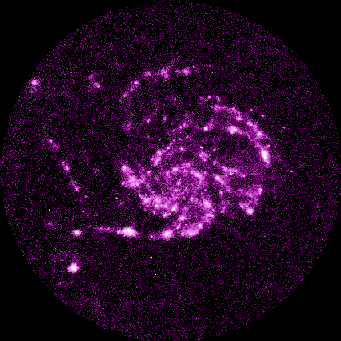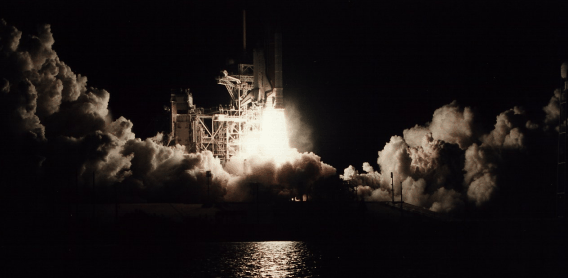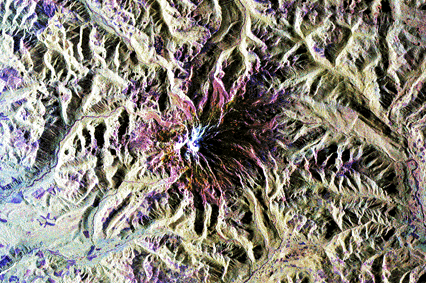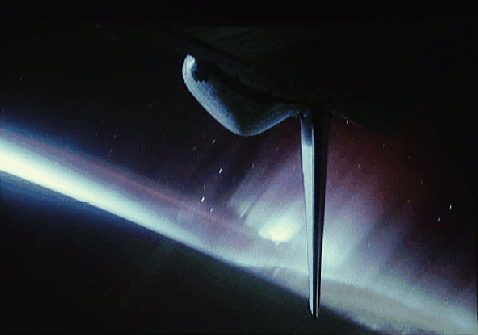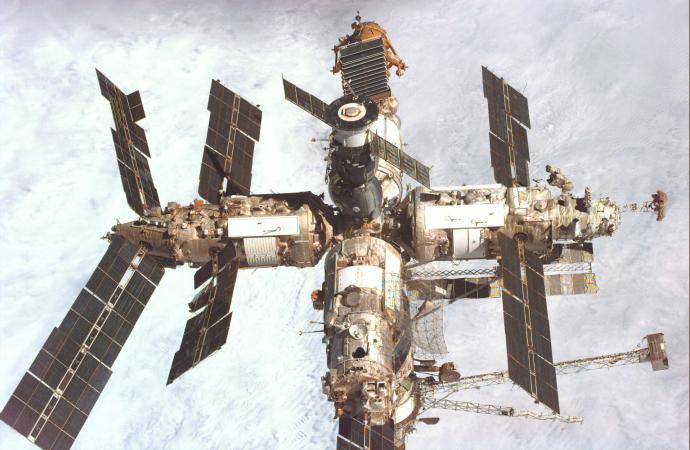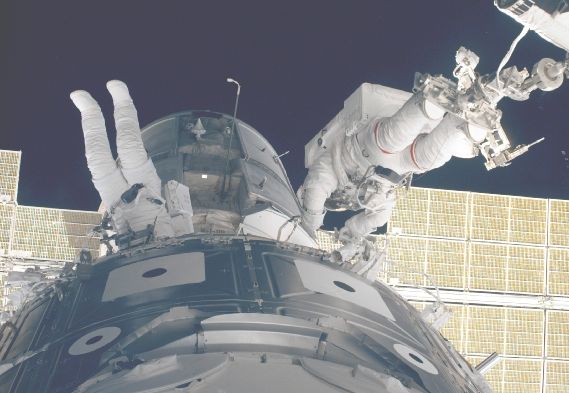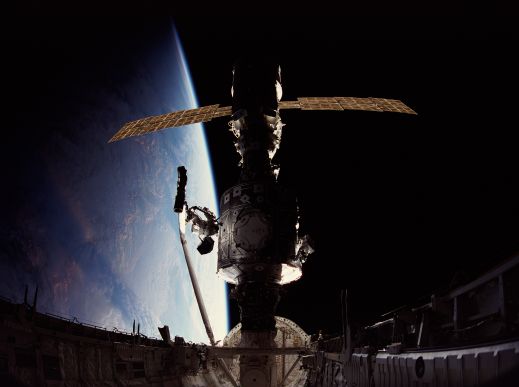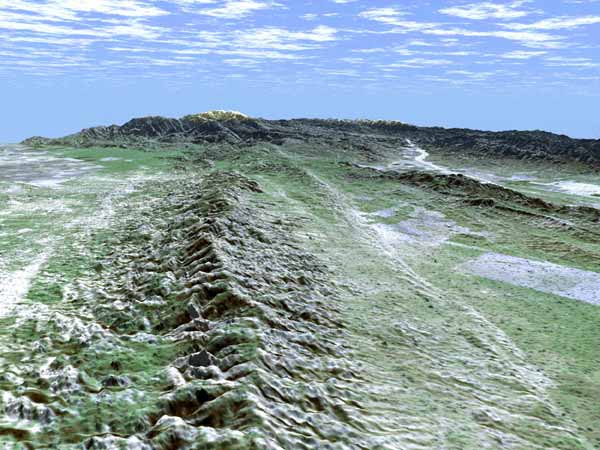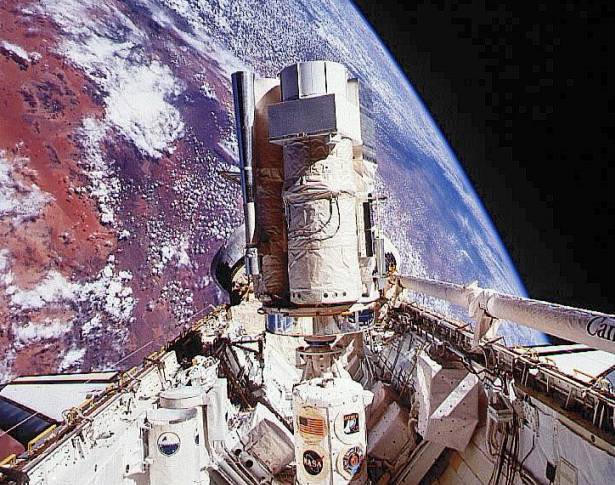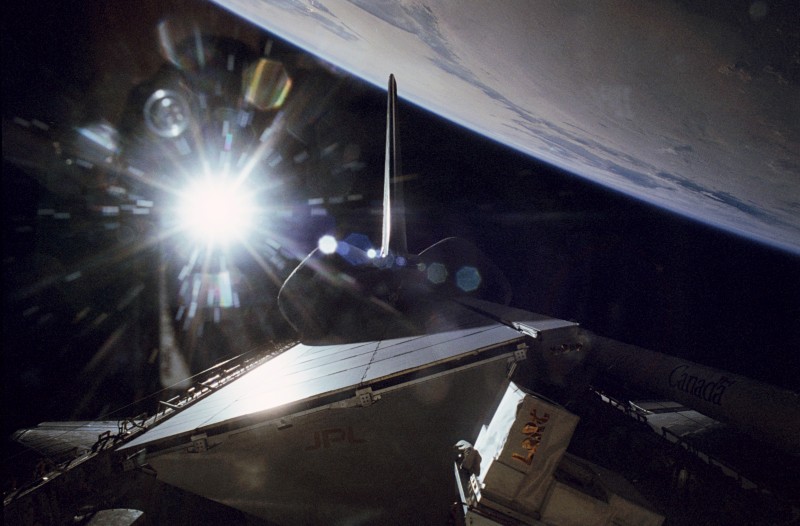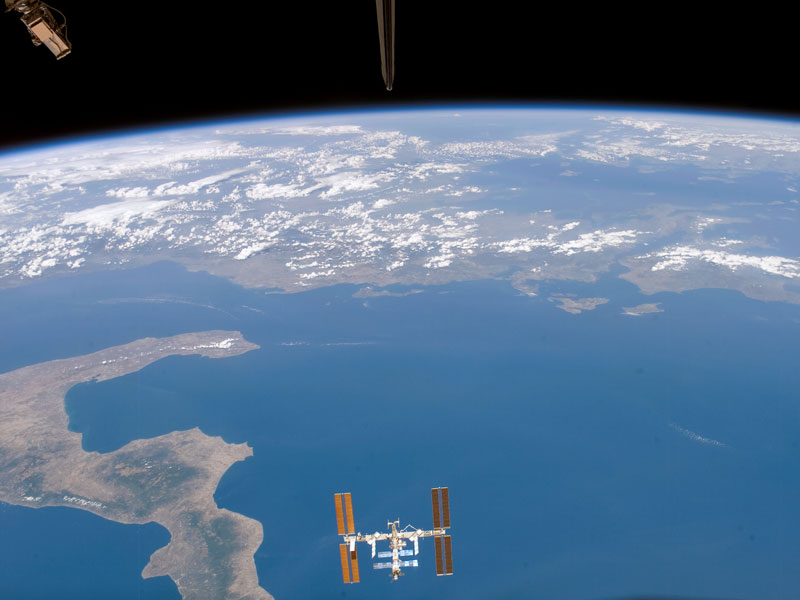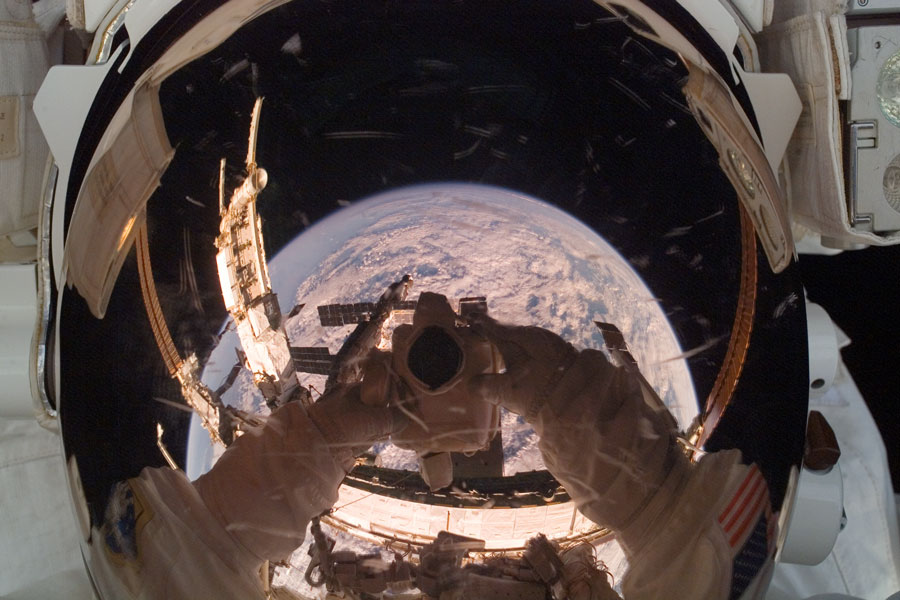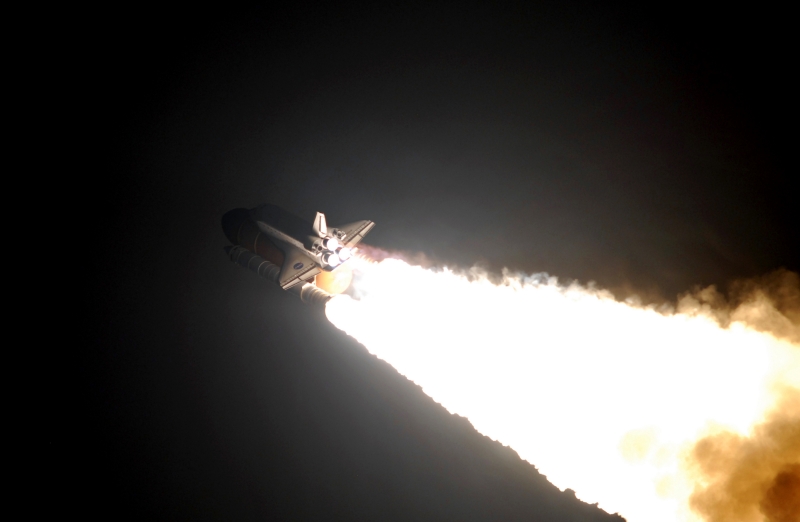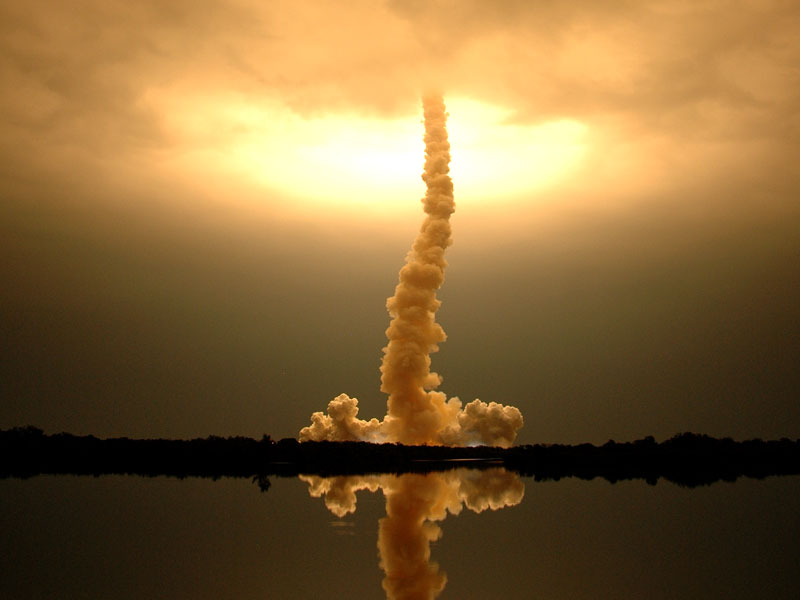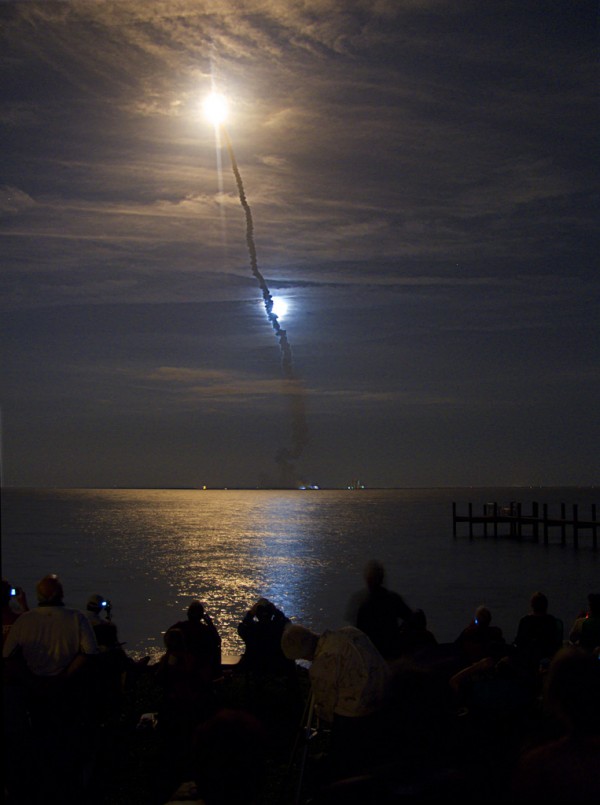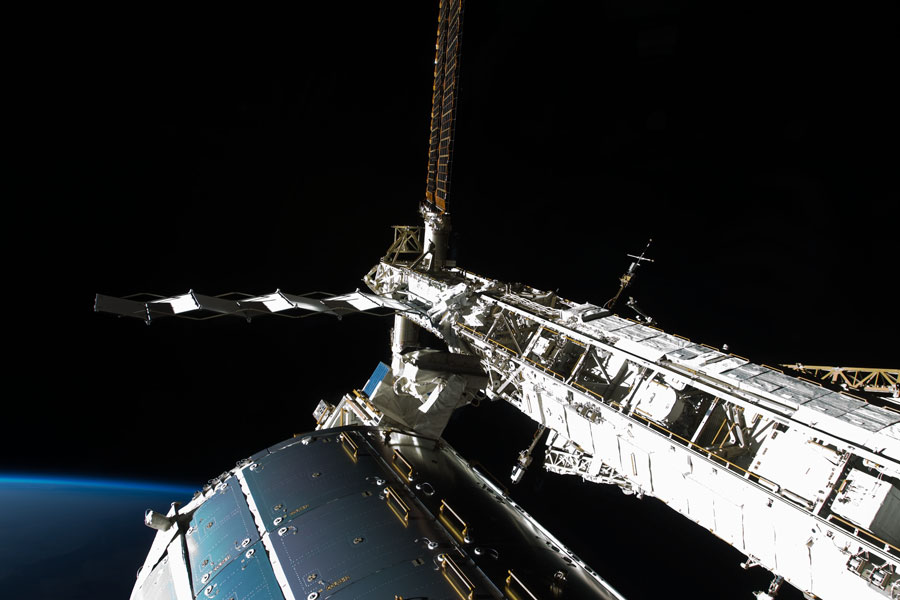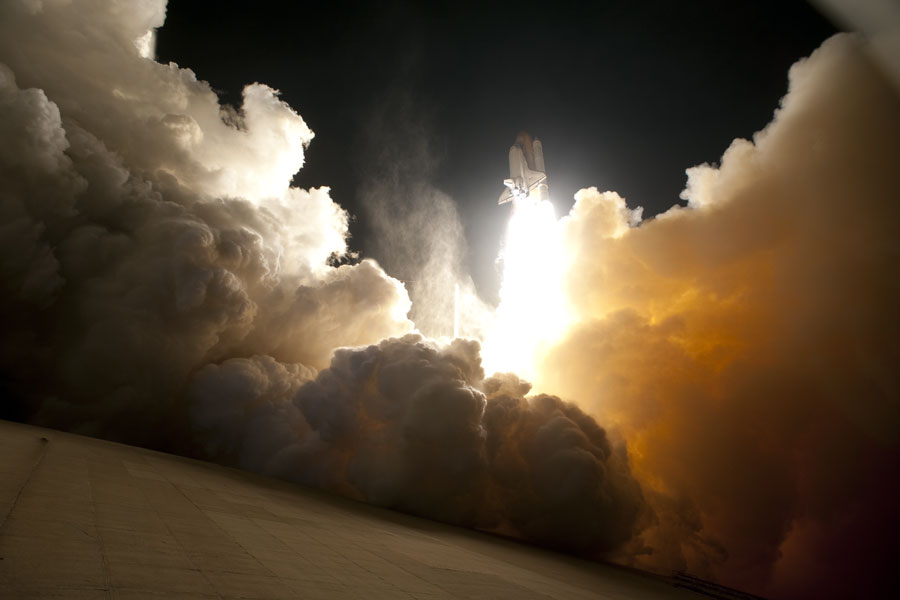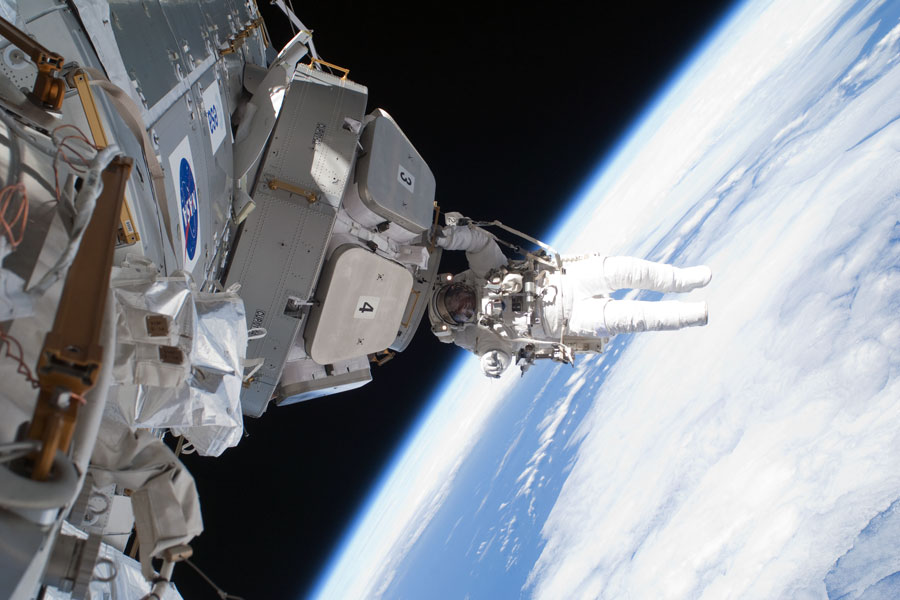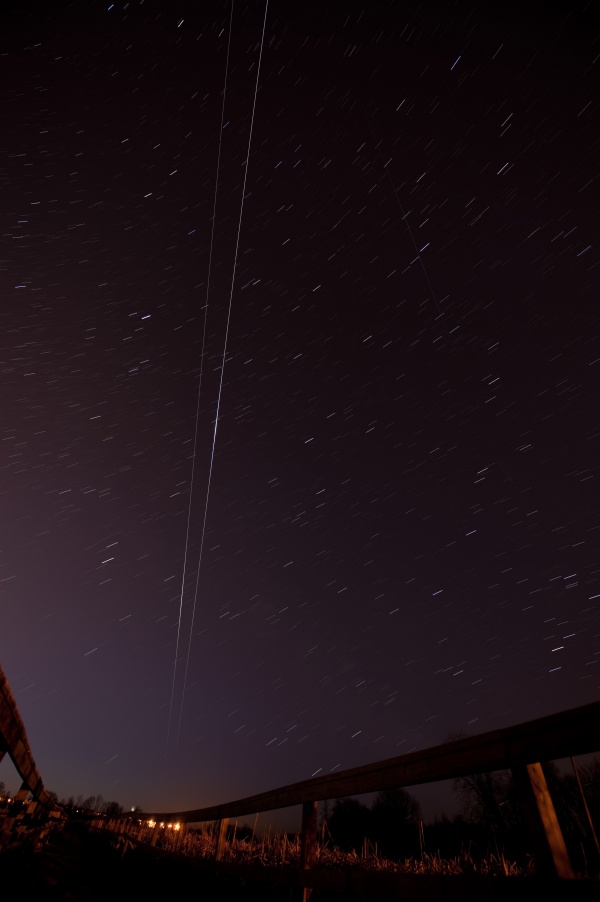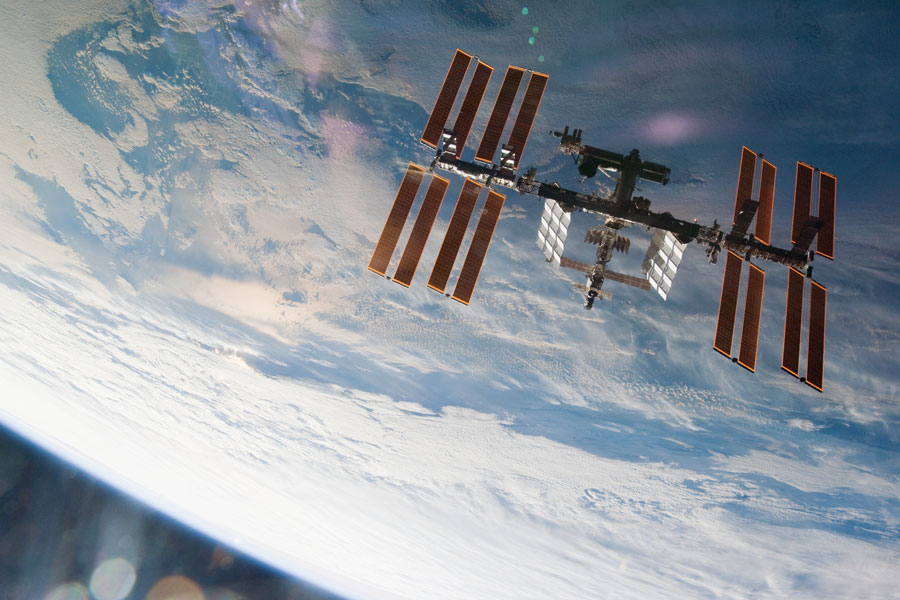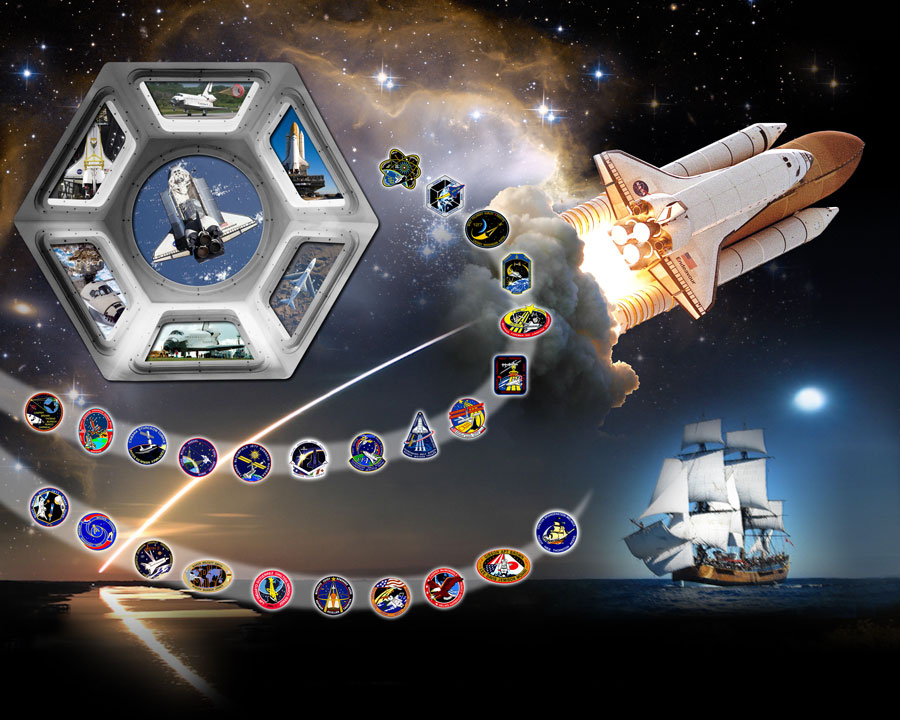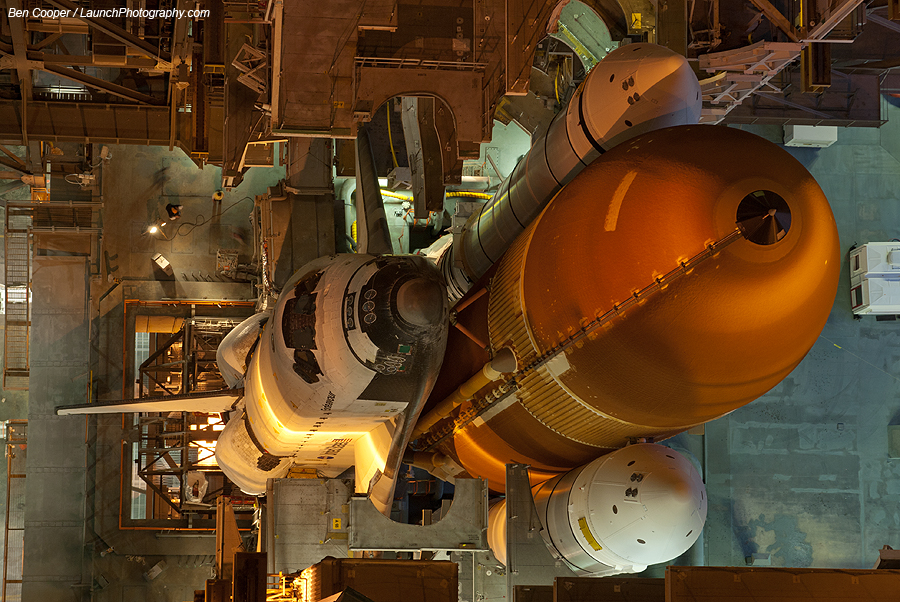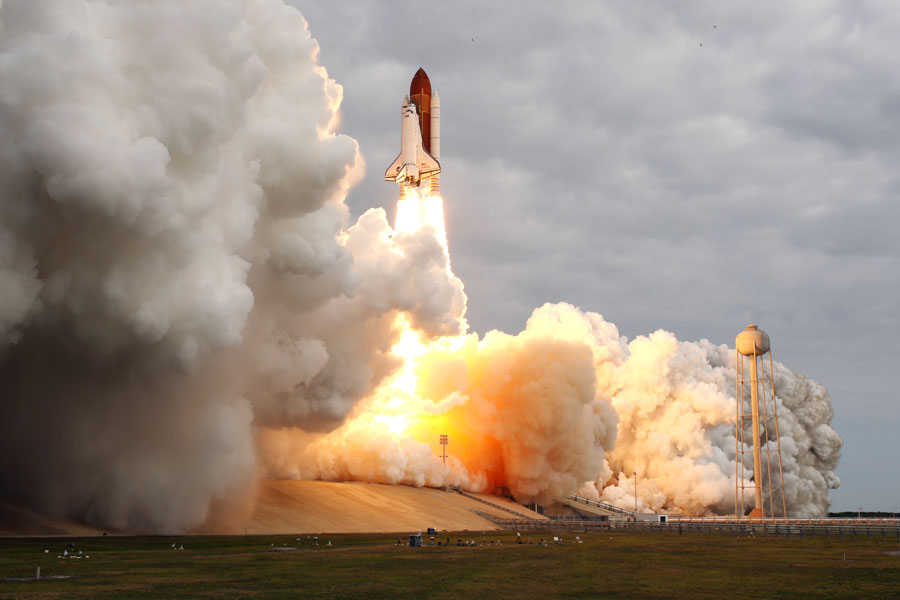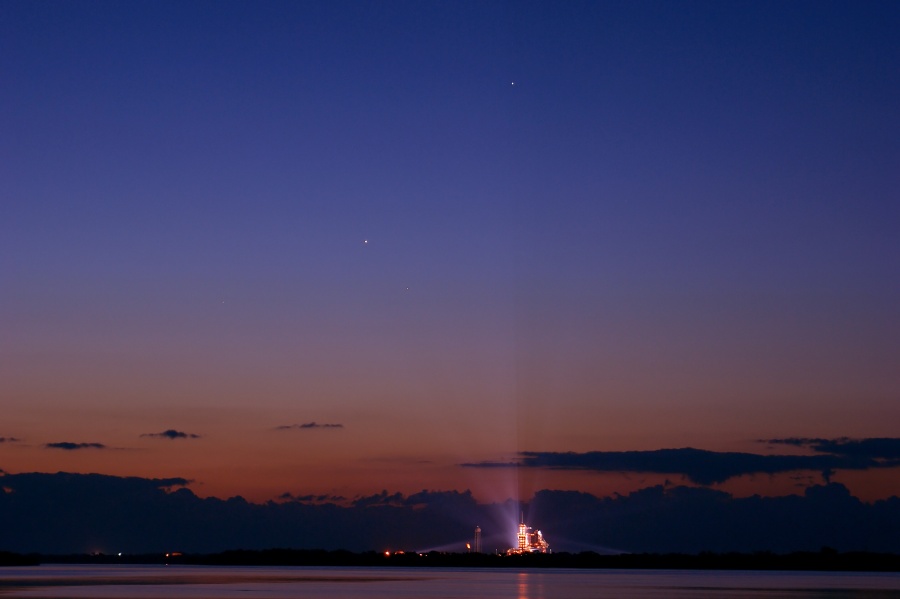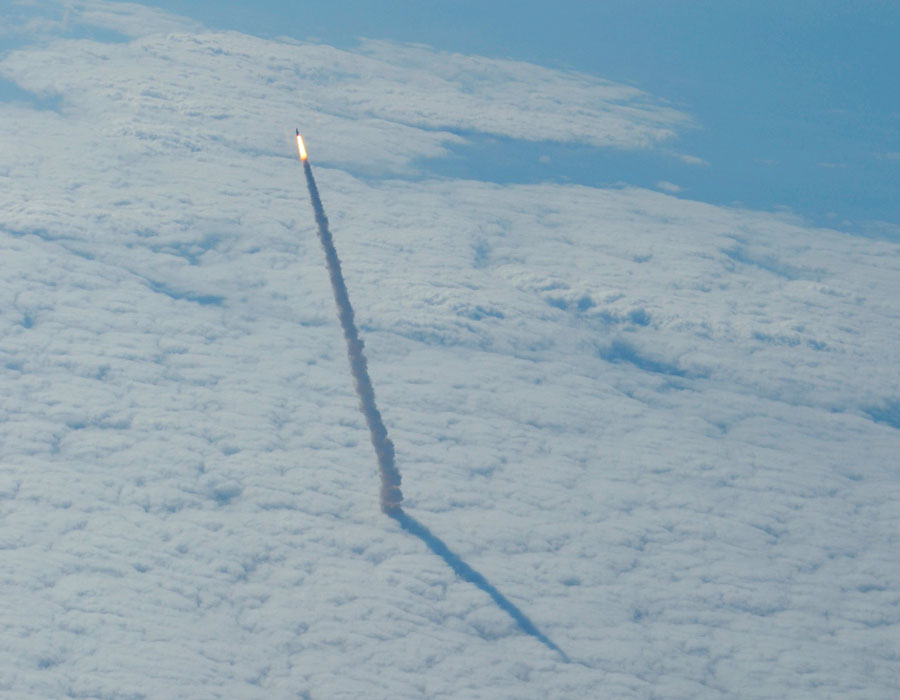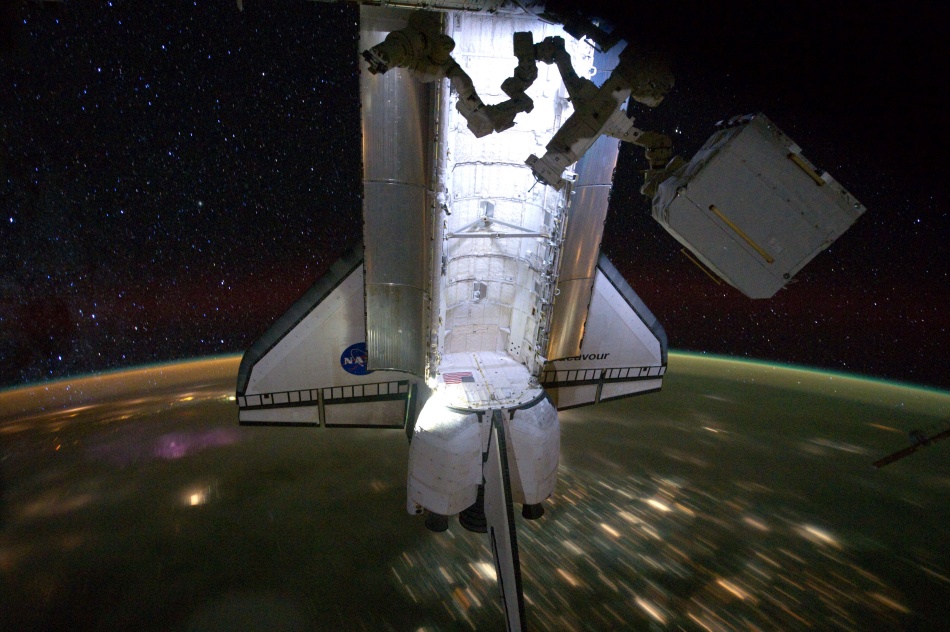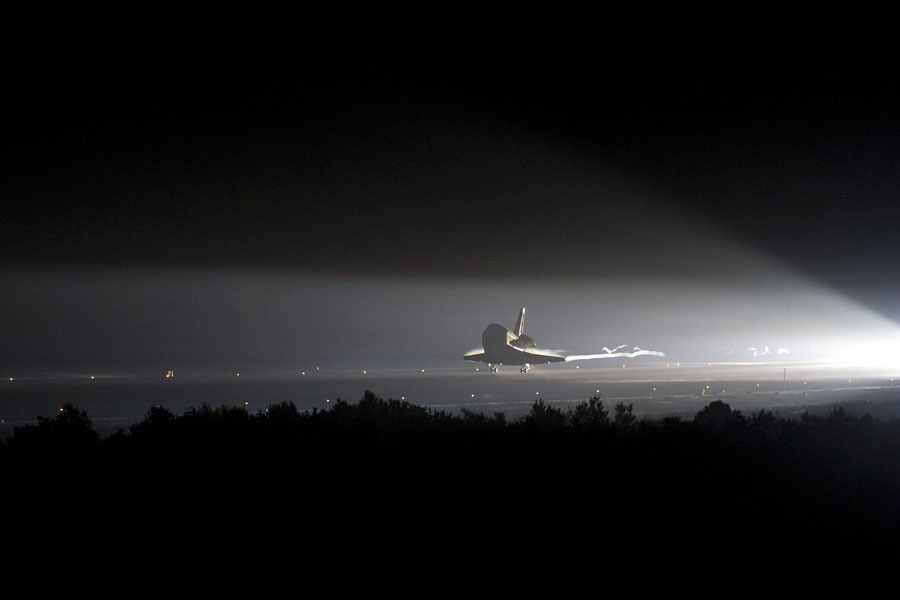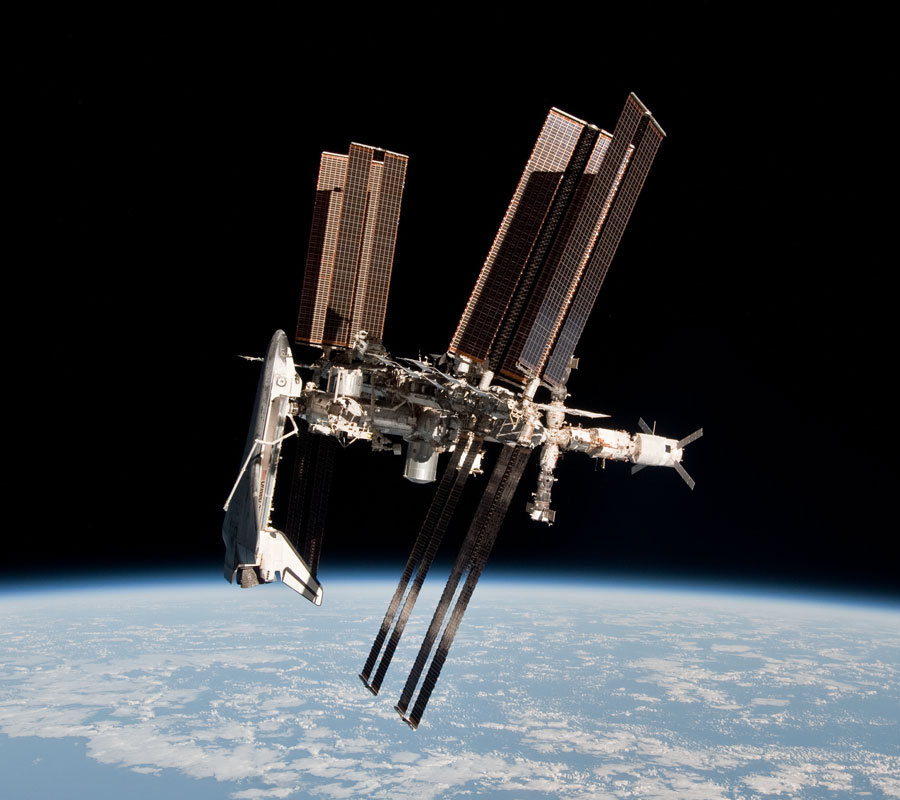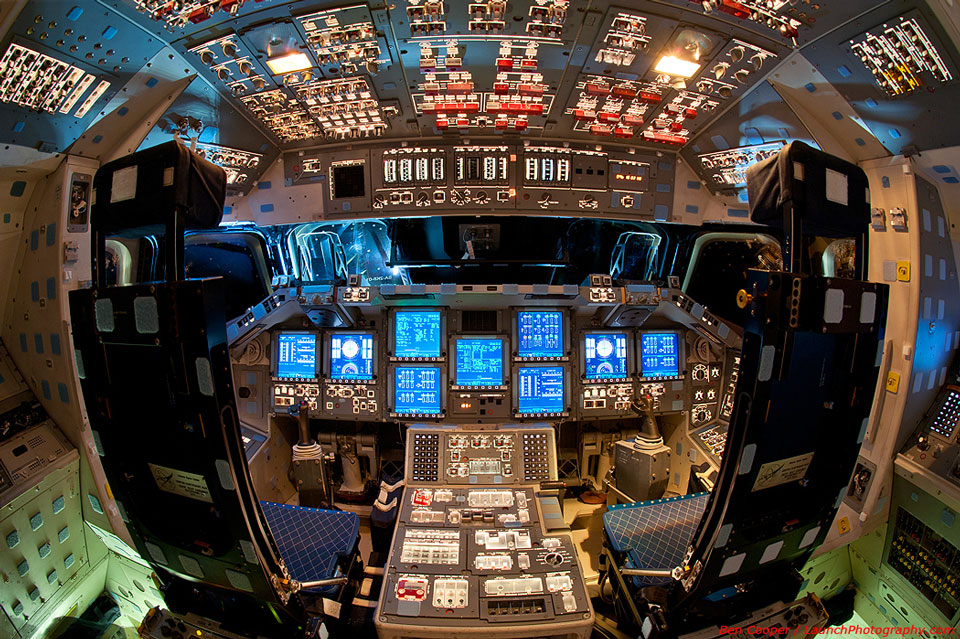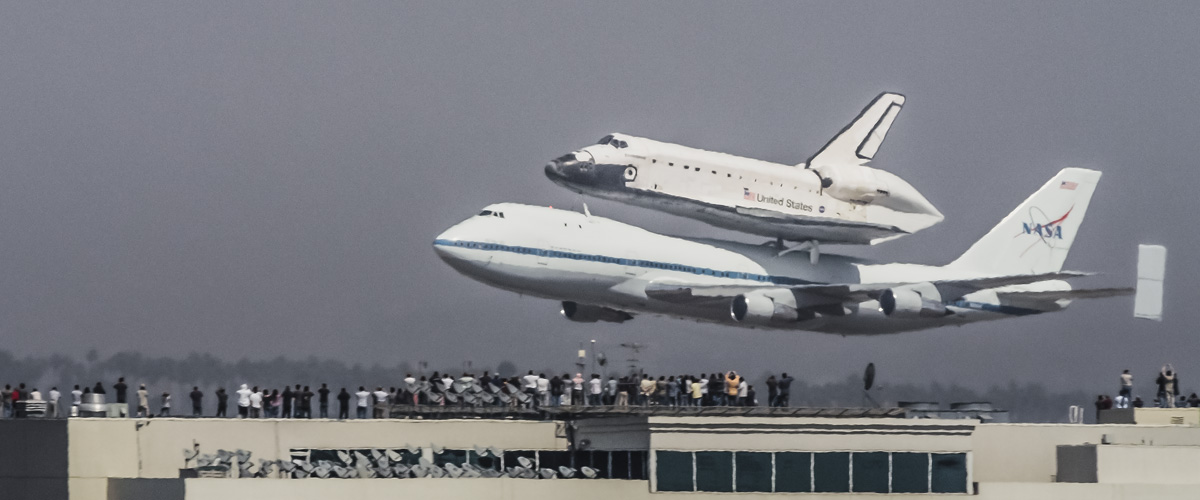___________
APODs
___________
This giant spiral galaxy, Messier 101 (M101), was photographed by the Ultraviolet Imaging Telescope onboard the Space Shuttle Endeavour during the Astro-2 mission (March 2 - 18, 1995). The image has been computer processed so that the colors represent the intensity of ultraviolet light. Pictures of galaxies like this one show mainly clouds of gas containing newly formed stars many times more massive than the sun, which glow strongly in ultraviolet light. In contrast, visible light pictures of galaxies tend to be dominated by the yellow and red light of older stars. Ultraviolet light, invisible to the human eye, is blocked by ozone in the atmosphere so ultraviolet pictures of celestial objects must be taken from space.
http://apod.nasa.gov/apod/ap950627.html Space Shuttle Endeavour thunders off into orbit in a rare night launch. This March 1995 mission is most famous for operating the set of astronomical telescopes known as Astro-2. Astro-2's telescopes observed the universe in ultraviolet light - light so blue humans by themselves can't see it. Astro-2 measured the amount of ultraviolet light emitted by several interesting stars, galaxies, planets, and QSOs. Analysis of data from this NASA mission has yielded the first clear detection of helium created during the beginning of the universe.
http://apod.nasa.gov/apod/ap950807.html This image of Mt. Rainier, Washington USA, planet Earth, was produced by the Spaceborne Radar Laboratory which flew on the Space Shuttle Endeavour in 1994. Radar, short for RAdio Detection And Ranging, is a technique which coordinates the operation of a radio transmitter and receiver to measure the direction, strength, and timing of radio echos from the surface of distant objects. An actual image of an object can be constructed by recording and analyzing many echos. One advantage of using radar imaging in planetary studies is that images can be made regardless of cloud cover or lighting conditions. During the early 90s, NASA's Magellan spacecraft was able to use radar imaging to produce similar high resolution maps of the surface of Venus.
http://apod.nasa.gov/apod/ap950824.html Sailing upside down, 115 nautical miles above Earth, the crew of the Space Shuttle Endeavour made this spectacular time exposure of the southern aurora (aurora australis) in October of 1994. The aurora, also known as the northern and southern lights, appear as luminous bands or streamers of light which can extend to altitudes of 200 miles. They are typically visible from the Earth's surface at high latitudes and are caused by high energy particles from the Sun. The delicate colors are caused by energetic electrons colliding with oxygen and nitrogen in the atmosphere. In this picture, the rear structure of the Space Shuttle is visible in the foreground with the vertical tail fin pointed toward Earth. Star trails are visible as small streaks above Earth's horizon.
http://apod.nasa.gov/apod/ap951026.html The Space Shuttle Discovery's orbital maneuvering system (OMS) engine firing produced this dramatic flare as it cruised "upside down" in low Earth orbit. Discovery was named for a ship commanded by Captain James Cook RN, the 18th Century English astronomer and navigator. Cook's voyages of discovery established new standards in scientific exploration and brought extensive knowledge of the unknown Pacific regions, including Australia, New Zealand, and the Hawaiian Island archipelago to Europeans. NASA's four-orbiter Space Shuttle fleet will begin a new year of operation on January 11, with the planned launch of the shuttle Endeavour (STS-72). Also named after one of Cook's ships, Endeavor is the latest addition to the shuttle fleet.
http://apod.nasa.gov/apod/ap960101.html
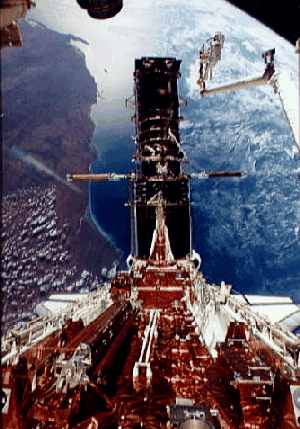
http://apod.nasa.gov/apod/ap960128.html Photographed from the approaching Space Shuttle Endeavour, the Mir space station floats above the clouds of planet Earth. Mir's modular construction, bristling with solar panels and antennas, lends it a slightly whimsical, insect-like appearance. Astronaut Andrew Thomas was dropped off at Mir by Endeavour in January and recently picked up by the Space Shuttle Discovery during STS-91, the ninth and last Mir docking mission. Thomas' 4 1/2 month stay culminates the shuttle-Mir program in which seven U.S. astronauts spent a total of 977 days with Russian crews on board Mir. The experience gained will be applied toward the construction of the International Space Station scheduled to begin with launches in November and December 1998.
http://apod.nasa.gov/apod/ap980703.html Batteries and solar panels were included with this version of the International Space Station (ISS) but some assembly is still required. On Saturday, December 5th, the STS-88 crew of the Space Shuttle Endeavor achieved the in orbit docking of the Zarya and Unity (foreground) ISS modules. On Monday, astronauts James Newman (left) and Jerry Ross continued the assembly procedures connecting power and data cables during the first of three planned spacewalks. Ground controllers were then able to successfully activate the ISS. Now orbiting planet Earth at an altitude of about 248 miles, Endeavour and the ISS are reported to be in excellent shape and crew members plan to enter the new space station today. Five Americans, one Russian, and the Unity module itself were lifted into orbit by the shuttle on Friday, December 4, while the Zarya (sunrise) module was launched on a Proton rocket from the Baikonur Cosmodrome in Kazakstan on November 20.
http://apod.nasa.gov/apod/ap981210.html Move over Mir, here comes the International Space Station. In December 1998, the crew of Space Shuttle Endeavour started construction by joining the U.S.-built Unity node with the Russian-built Zarya module. A close look at the above IMAX(r) photograph will reveal two astronauts working on Unity. Below on Earth, the terminator between night and day is visible. The International Space Station's low 250-mile Earth orbit causes it to experience one complete day/night cycle in about 90 minutes.
http://apod.nasa.gov/apod/ap990223.html The Earth's surface is broken. Cracks in the Earth's crust known as faults can run for hundreds of kilometers. These faults are frequently the sites of major earthquakes as the tectonic plates that cover the surface of the Earth shift. Pictured above is San Andreas Fault in California, one of the longest and most active faults. Visible as the linear feature to the right of the mountains, San Andreas Fault reaches 15 kilometers deep and is about 20 million years old. The above exaggerated-height image was created by combining radar deployed by the Space Shuttle Endeavour in February with a true-color Landsat picture. Along San Andreas Fault, the titanic Pacific Plate is shifting relative to the huge North American Plate by an average of a few centimeters per year. At that rate, in a few million years, the Earth's surface will look quite different than it does today.
http://apod.nasa.gov/apod/ap001207.html Six years ago, a cluster of three ultraviolet telescopes flew into orbit on the Astro-2 mission aboard the space shuttle Endeavour. Seen here perched in Endeavour's payload bay about 350 kilometers above the Australian desert are the Hopkins Ultraviolet Telescope (HUT), the Ultraviolet Imaging Telescope (UIT), and the Wisconsin Ultraviolet Photo-Polarimeter Experiment (WUPPE). HUT is in front of the other instruments with a silver, conical-shaped star tracker at the left of the telescope cluster. The ultraviolet region of the electromagnetic spectrum lies at wavelengths shorter than blue light and can not be seen by human eyes. Almost all ultraviolet light from the cosmos is impossible to detect at the Earth's surface because it is absorbed by atmospheric ozone. But cruising high above the clouds and protective atmosphere, these instruments could explore the universe at wavelengths beyond the blue.
http://apod.nasa.gov/apod/ap010317.html Today, the Sun crosses the celestial equator heading south at 0951 UT. Known as the equinox, the astronomical event marks the first day of autumn in the northern hemisphere and spring in the south. Equinox means equal night and with the Sun on the celestial equator, Earth dwellers will experience nearly 12 hours of daylight and 12 hours of darkness. Of course, for those in the south, the days will grow longer with the Sun marching higher in the sky as summer approaches. A few weeks after the September Equinox of 1994, the Crew of the shuttle orbiter Endeavour recorded this image of the Sun poised above the Earth's limb. Glare illuminates Endeavour's vertical tail (pointing toward the Earth) along with radar equipment in the payload bay.
http://apod.nasa.gov/apod/ap070923.html Last August, the Space Shuttle Endeavour crew captured this shot of the International Space Station (ISS) against the backdrop of Planet Earth. During that trip to the ISS, the space shuttle crew re-supplied the station, repaired the station, and even built more of the station. Its primary mission complete, the crew took the premier spaceship on a tour around the premier space station. Pictured during this inspection tour, the ISS is visible in front the Ionian Sea. The boot of Italy is visible on the left, while the western coastlines of Greece and Albania stretch across the top. The dorsal fin of the upside-down shuttle orbiter pokes into the very top of the image. The Space Shuttle Discovery subsequently visited the ISS in October while the next shuttle mission to the ISS is scheduled for next week.
http://apod.nasa.gov/apod/ap071127.html Astronaut self-portraits can be particularly interesting. Visible in the above picture, working in from the outer borders, are the edges of the reflecting helmet of a space suit, modules of the International Space Station (ISS), the Earth, the arms of Expedition 15 astronaut Clay Anderson, and the digital camera used to snap the image. This picture was taken during the shuttle orbiter Endeavour's mission to expand the space station last August. The large curvature of the Earth appearing in the visor reflection is not the true curvature of our spherical Earth, but rather an artifact of the curve of the space helmet. Earth's horizon appears only slightly curved when viewed from the height of the ISS -- approximately 400 kilometers. The next space shuttle mission to the space station is currently expected to take place next month and includes the installation of the scientific Columbus Laboratory.
http://apod.nasa.gov/apod/ap080123.html Blasting into a dark night sky, the Space Shuttle Endeavour began its latest journey to orbit in the early morning hours of March 11. In this stunning picture following the launch, the glare from Endeavour's three main rocket engines and flanking solid fuel booster rockets illuminates the orbiter's tail section and the large, orange external fuel tank. Embarking on mission STS-123, Endeavour left Kennedy Space Center's pad 39A, ferrying a crew of seven astronauts to the International Space Station (ISS). The cargo included the first section of the Japan Aerospace Exploration Agency's Kibo laboratory and the Canadian Space Agency's two-armed robotic system. Astronauts will conduct a series of space walks to install the new equipment during the 16-day mission, the longest shuttle mission to the ISS.
http://apod.nasa.gov/apod/ap080314.html Birds don't fly as high. Airplanes don't go as fast. The Statue of Liberty weighs less. No species other than human can even comprehend what is going on, nor could any human just a millennium ago. The launch of a rocket bound for space is an event that inspires awe and challenges description. The exhaust column pictured is from the Space Shuttle Endeavour after last week's night launch to visit the International Space Station. Endeavour's rocket engines create the dramatic glow from above the clouds. From a standing start, the two million kilogram rocket ship left to circle the Earth where the outside air is too thin to breathe and where there is little noticeable onboard gravity. Rockets bound for space are now launched from somewhere on Earth about once a week.
http://apod.nasa.gov/apod/ap080316.html Glaring near the top of the frame, the shuttle orbiter Endeavour rockets into the night on the STS-126 mission. Endeavour left planet Earth on November 14 from Launch Pad 39A at NASA's Kennedy Space Center, making the 27th flight to the International Space Station. To record the dramatic view, the camera was placed so the shuttle's flight path tracked across the Moon, from a vantage point in Indian River City, Florida. Near picture center the almost full, perigee Moon shining through thin clouds silhouettes the shuttle's dense exhaust trail. On board the space station, the crew and the STS-126 astronauts can celebrate the orbital outpost's 10th anniversary today. Construction of the International Space Station officially began with the November 20, 1998 Russian launch of the station's first element, the bus-sized Zarya module.
http://apod.nasa.gov/apod/ap081120.html Where's the astronaut? Somewhere in this impressive array of International Space Station (ISS) hardware, astronaut Steve Bowen can be found upgrading and cleaning key parts of Earth's most prominent orbital outpost. Astronaut Bowen and Heidemarie Stefanyshyn-Piper (not pictured), part of the Space Shuttle Endeavour's recently ended STS-126 mission to the ISS, spent nearly three hours on this spacewalk hovering high above planet Earth. Bowen progressed toward achieving a key goal of the mission -- servicing of the Solar Alpha Rotary Joints to better allow some solar arrays to track the Sun. In the lower foreground of the above image is the cylindrical Columbus Laboratory, protruding from the right is an impressively large space station truss, while in the background are some of the expansive solar arrays that collect sunlight to power the ISS. Far in the distance, a blue arc of Earth's thin atmosphere is visible on the horizon. The next space shuttle flight is scheduled for 2009 February, when Discovery will deliver elements to further expand the ISS.
http://apod.nasa.gov/apod/ap081202.html Sometimes, the space shuttle launches at night. Pictured above, the space shuttle Endeavour lifted off in yesterday's early morning hours from Launch Pad 39A in Kennedy Space Center, Florida, USA, bound for the International Space Station (ISS). A night launch, useful for reaching the space station easily during some times of the year, frequently creates vivid launch imagery. The shuttle, as pictured above, is framed by an enormous but typical exhaust plume ejected as the shuttle's powerful rockets began lifting the two million kilogram space bus into Earth orbit. Endeavour's mission, labeled STS-130, includes the delivery of the Tranquility module to the space station. Tranquility will provide extra room for space station astronauts and includes a large circular set of windows designed to bestow vastly improved views of the Earth, the night sky, and the space station itself.
http://apod.nasa.gov/apod/ap100209.html This space job was almost complete. Floating just below the International Space Station, astronaut Nicholas Patrick put some finishing touches on the newly installed cupola space windows last week. Patrick was a mission specialist onboard the recently completed space shuttle Endeavor's STS-130 mission to the ISS. Pictured, Patrick floats near the outermost of seven windows on the new cupola of the just-installed Tranquility module. Patrick hovers about 340 kilometers over the Earth's surface, well in front of the blue sky, blue water, and white clouds pictured far in the background. In the above image, covers on windows three and four were in place and clearly labelled. Images from inside the ISS's new panoramic cupola are now available.
http://apod.nasa.gov/apod/ap100216.html On February 21st, the Space Shuttle Endeavour and the International Space Station (ISS) flew through the sky near dawn over Whitby, Ontario, Canada. Along with star trails, both were captured in this single time exposure. Glinting in sunlight 350 kilometers above the Earth, Endeavour slightly preceeded the ISS arcing over the horizon. But the brighter trail and the brighter flare belongs to the space station just visited by Endeavour. Near the completion of the STS-130 mission, hours later Endeavour made a night landing at Kennedy Space Center.
http://apod.nasa.gov/apod/ap100227.html The International Space Station (ISS) is the largest human-made object ever to orbit the Earth. The ISS is so large that it can be seen drifting overhead with the unaided eye, and is frequently imaged from the ground in picturesque fashion. Last month, the station was visited again by space shuttle, which resupplied the station and added a new module. The ISS is currently operated by the Expedition 22 crew, now consisting five astronauts including two supplied by USA's NASA, two by Russia's RKA, and one by Japan's JAXA. After departing the ISS, the crew of the space shuttle Endeavour captured the above spectacular vista of the orbiting space city high above the clouds, waters, and lands of Earth. Visible components include modules, trusses, and expansive solar arrays that gather sunlight that is turned into needed electricity.
http://apod.nasa.gov/apod/ap100303.html They are some of the most complex machines ever built. From a standing start they can launch a school- bus sized object up so high and moving so fast that it won't fall back down. They have launched numerous revolutionary satellites that enable humans to communicate across the globe, to better understand Earth's atmosphere, and to peer into the distance universe. They are NASA's Space Shuttles, and NASA has recently released large digital posters to honor them. While the inaugural flight was in 1981, the shuttle fleet is aging and is now nearing retirement. Pictured above, the space shuttle Endeavour is shown rising to orbit, with patches for each of its missions shown in a spiral. Endeavour was named for the HMS Endeavour, a British research ship that explored the south Pacific Ocean in the 1700s, depicted on the lower right. On the upper left are panoramic windows delivered by Endeavour to the International Space Station earlier this year. In the background near the top is the NGC 602 nebula as imaged by the Hubble Space Telescope, which was serviced by Endeavour in 1993. Posters for all of the shuttles, including Atlantis, Challenger, Columbia, Discovery, Endeavour are available.
http://apod.nasa.gov/apod/ap100907.html First flown in 1992, Endeavour, the youngest space shuttle orbiter, is being prepared for its 25th and final trip to low Earth orbit. Seen here from an exciting perspective 400 feet above the floor of Kennedy Space Center's Vehicle Assembly Building, Endeavour (OV-105) is mated to an external tank and solid rocket boosters just prior to roll out to launch pad 39A on March 11. The completed space shuttle stands over 18 stories tall. Intended for an April 19 near sunset launch on STS-134, Endeavour will head for the International Space Station and deliver the AMS cosmic ray experiment. The final flight of Endeavour will be the penultimate planned space shuttle flight.
http://apod.nasa.gov/apod/ap110402.html Two days ago, powerful yet controlled explosions rocketed the Space Shuttle Endeavour on its final trip into Earth orbit. The above image was taken seconds after liftoff as the massive orbiter and six astronauts began a climb to a height where the atmosphere is so thin it is unbreathable. The shuttle, on mission STS-134, is expected to dock with the International Space Station (ISS) today. The Endeavour will deliver to the ISS, among other things, an ambitious detector called the Alpha Magnetic Spectrometer 2 (AMS), a detector that over the next few years could detect a significant abundance of specific types of dark matter, charged antimatter, and even a strangely possible variation of familiar matter called strangelets. The very last trip for any space shuttle is currently planned for mid-July when Atlantis will also visit the space station. When dawn broke over Kennedy Space Center on Monday, May 16, the space shuttle orbiter Endeavour still stood on pad 39A. Its final launch, on mission STS-134 to the International Space Station, was only hours away. Shining through the early morning twilight four planets were also poised above the eastern horizon, a moving scene captured here from across the Banana River at the center's Saturn V VIP viewing site. Scattered by planet Earth's dense atmosphere, floodlight beams play over the launch pad, glancing skyward toward the celestial beacons. Jupiter is highest, near the top of the frame, but even the solar sytem's ruling gas giant is outshone by brilliant Venus near picture center. Innermost planet Mercury is below Venus, to the right. Below and left, Mars almost fades into the twilight glow. The four planets continue to hug the eastern horizon at dawn throughout the month, while Endeavour is now scheduled to make its final approach to planet Earth on June 1. What's that rising from the clouds? The space shuttle. If you looked out the window of an airplane at just the right place and time last week, you could have seen something very unusual -- the space shuttle Endeavour launching to orbit. Images of the rising shuttle and its plume became widely circulated over the web shortly after Endeavour's final launch. The above image was taken from a shuttle training aircraft and is not copyrighted. Taken well above the clouds, the image can be matched with similar images of the same shuttle plume taken below the clouds. Hot glowing gasses expelled by the engines are visible near the rising shuttle, as well as a long smoke plume. A shadow of the plume appears on the cloud deck, indicating the direction of the Sun. The shuttle Endeavour remains docked with the International Space Station and is currently scheduled to return to Earth next week. This luminous night view of the space shuttle orbiter Endeavour, docked with the International Space Station for a final time, was captured on May 28. Orbiting 350 kilometers above planet Earth, Endeavour's payload bay is lit up as it hurtles through Earth's shadow at 17,000 miles per hour. At the top of the frame, the jointed appendages of the station's robotic manipulator arm Dextre appear in silhouette. Motion during the long exposure produced streaks in the starry background and the city lights on the darkened planet below. Completing a 16 day mission, Endeavour made a final landing at Kennedy Space Center in the dark, early morning hours of June 1. Space shuttle Endeavour is home to stay. In a rare night landing last week, Endeavour glided onto a runway in Cape Canaveral, Florida, USA completing a 16-day mission that included a visit to the International Space Station (ISS). All told, space shuttle Endeavour flew 25 flights since being deployed by NASA in 1992, spending a total of 299 days in space. Endeavour's next mission will be a stationary one in the California Science Center. Even as Endeavour was landing, the space shuttle Atlantis was being rolled out in preparation for the last mission of any Space Shuttle, a mission currently scheduled to begin on July 8. How was this picture taken? Usually, pictures of the shuttle, taken from space, are snapped from the space station. Commonly, pictures of the space station are snapped from the shuttle. How, then, can there be a picture of both the shuttle and the station together, taken from space? The answer is that during the Space Shuttle Endeavour's last trip to the International Space Station two weeks ago, a supply ship departed the station with astronauts that captured a series of rare views. The supply ship was the Russian Soyuz TMA-20 which landed in Kazakhstan later that day. The above spectacular image well captures the relative sizes of the station and docked shuttle. Far below, clouds of Earth are seen above a blue sea. The next and last launch of a US space shuttle is scheduled for early July. What would it be like to fly a space shuttle? Although the last of NASA's space shuttles has now been retired, it is still fun to contemplate sitting at the controls of one of the humanity's most sophisticated machines. Pictured above is the flight deck of Space Shuttle Endeavour, the youngest shuttle and the second to last ever launched. The numerous panels and displays allowed the computer-controlled orbiter to enter the top of Earth's atmosphere at greater than the speed of sound and -- just thirty minutes later -- land on a runway like an airplane. The retired space shuttles are now being sent to museums, with Endeavour being sent to California Space Center in Los Angeles, California, Atlantis to the Kennedy Space Center Visitor Complex on Merritt Island, Florida, and Discovery to the Udvar-Hazy Annex of the National Air and Space Museum in Chantilly, Virginia. Therefore sitting in a shuttle pilot's chair and personally contemplating the thrill of human space flight may actually be in your future.
________________________
Images from Asterisk
________________________
Endeavour on Top of Pad 39A
http://www.universetoday.com/84053/shut ... al-flight/
Copyright: Ken Kremer First seen here
STS-134, Endeavour
Copyright: James N. Brown First seen here
Endeavour Final Rollout, March 11
Copyright: Ben Cooper/SpaceflightNow.com & LaunchPhotography.com First seen here
Best. Shuttle Image. Ever | Universe Today - 2010 Feb 12
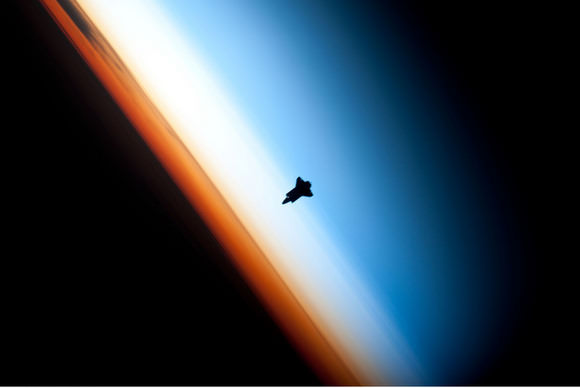
Space shuttle Endeavour in Earth's limb as it approaches the ISS prior to docking. Credit: NASA
First seen here
http://spaceflight.nasa.gov/gallery/ima ... 06555.html
Hi Res: http://spaceflight.nasa.gov/gallery/ima ... 006555.jpg First seen here
